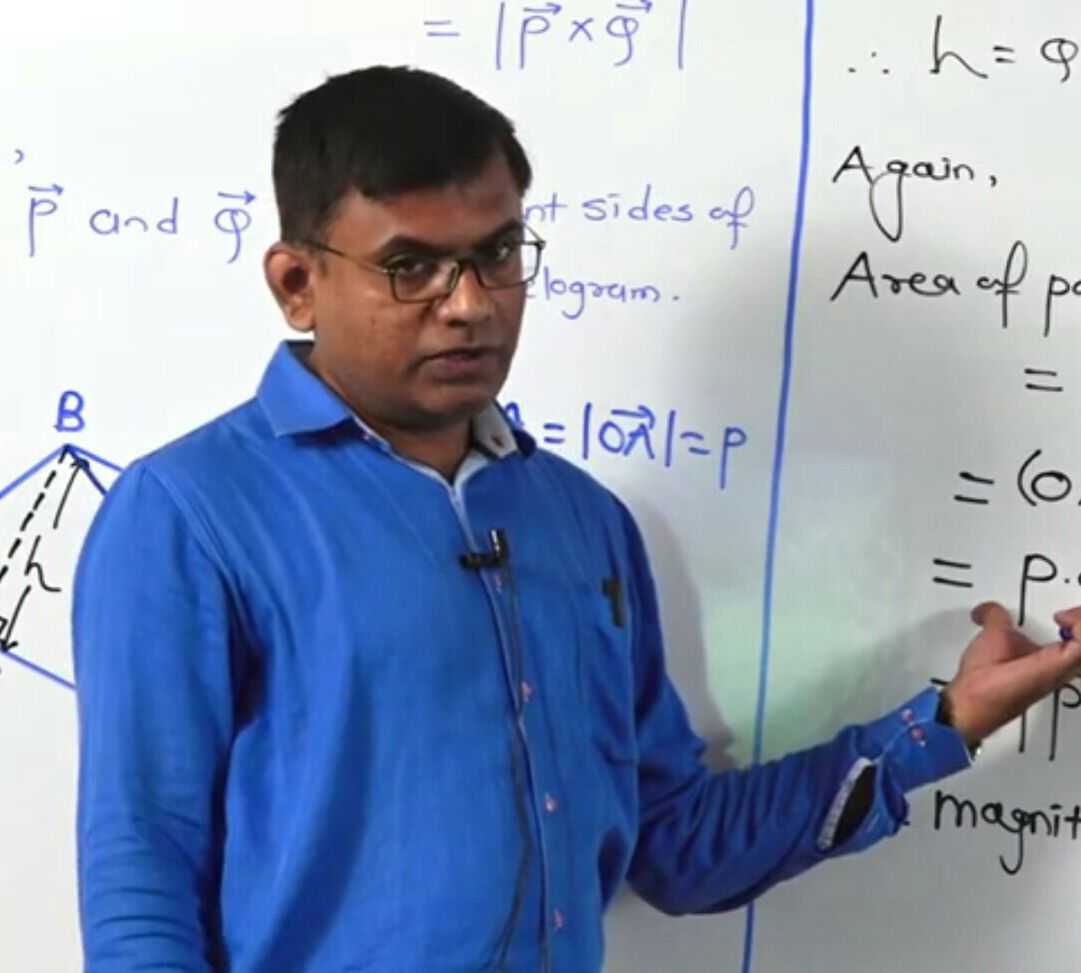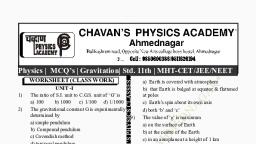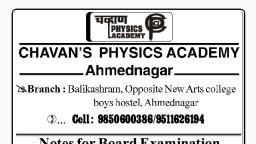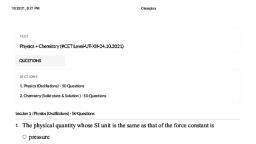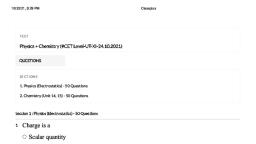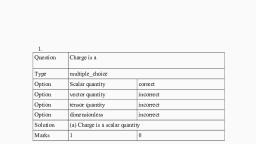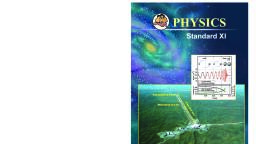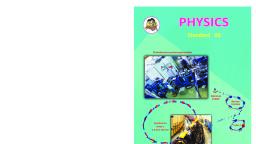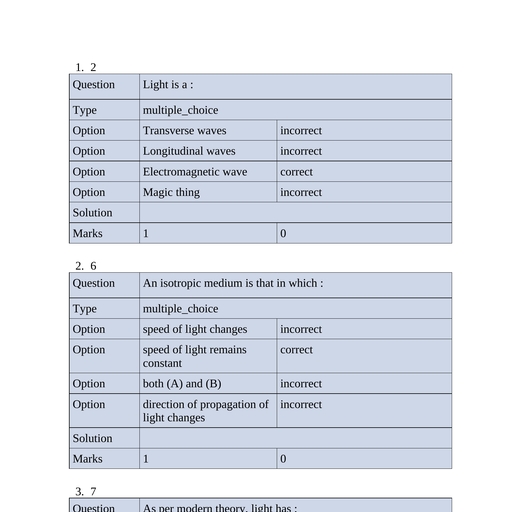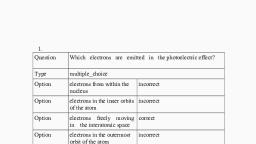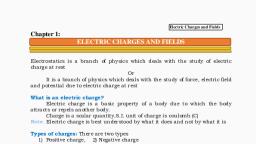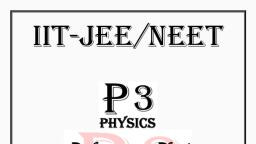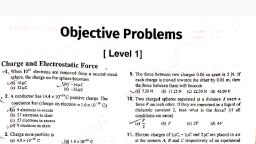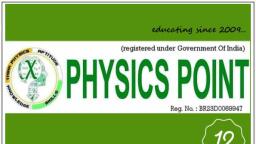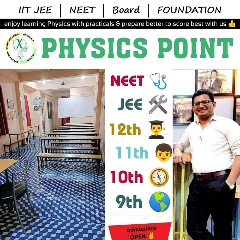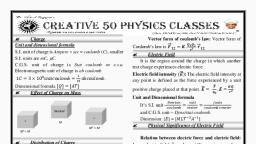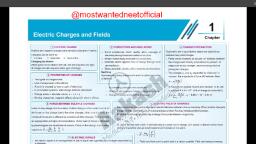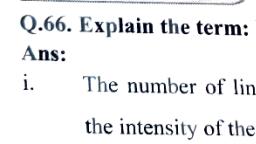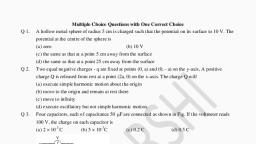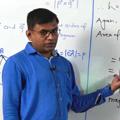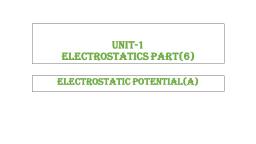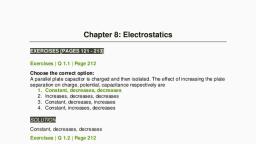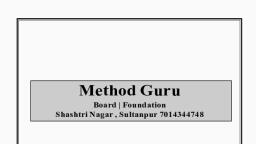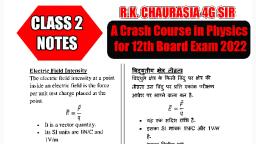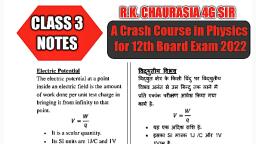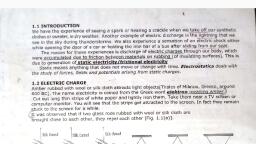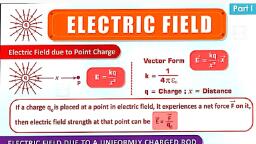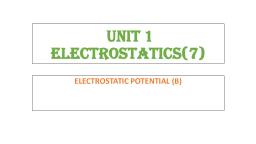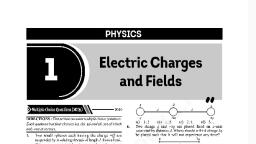Page 2 :
1., Explain: Atoms are electrically neutral., Ans :, i), Matter is made up of atoms which in turn, consists of elementary particles proton., neutron and electron., ii) A proton is considered to be positively, charged and electron to be negatively charged., ii) Neutron is electrically neutral i.e., it has no, charge., iv. An atomic nucleus is made up of protons and, neutrons and hence is positively charged., Negatively charged electrons surround the, nucleus so as to make an atom electrically, neutral., 2., Explain concept of charging by conduction., Ans.:, i), When certain dissimilar substances, like fur, and amber or comb and dry hair, are rubbed, against each other, electrons get transferred to, the other substance making them charged., ii) The substance receiving electrons develops a, negative charge while the other is left with an, equal amount of positive charge., iii) This can be called charging by conduction as, charges are transferred from one body to, another., 3., Explain concept of charging by induction., i), If an uncharged conductor is brought near a, charged body, (not in physical contact) the, nearer side of the conductor develops opposite, charge to that on the charged body and the far, side of the conductor develops charge similar, to that on the charged body. This is called, induction., ii) This happens because the electrons in, a conductor are free and can move easily in, presence of charged body., iii) A charged body attracts or repels electrons, in a conductor depending on whether the, charge on the body is positive or negative, respectively., iv. Positive and negative charges are redistributed, and are accumulated at the ends of the, conductor near and away from the charged, body., v., In induction, there is no transfer of charges, between the charged body and the conductor., So when the charged body is moved away, from the conductor, the charges in the, conductor are free again., 11th (Sci.) – Electrostatics, , 4. Can you recall?, i) When a petrol or a diesel tanker is emptied in a, tank, it is grounded., ii) A thick chain hangs from a petrol or a diesel, tanker and it is in contact with ground, when the tanker is moving., Ans., i) When a petrol or a diesel tanker is emptied in a, tank, it is grounded so that it has an electrically, conductive connection from the petrol or diesel, tank to ground (Earth) to allow leakage of static, and electrical charges., ii) Metallic bodies of cars, trucks or any other big, vehicles get charged because of friction between, them and the air rushing past them. Hence, a, thick chain is hanged from a petrol or a diesel, tanker to make a contact with ground so that, charge produced can leak to the ground through, chain, 5. Explain the concept of additive nature of charge., Ans :, i) Electric charge is additive, similar to mass. The, total electric charge on an object is equal to the, algebraic sum of all the electric charges distributed, on different parts of the object., ii) It may be pointed out that while taking the, algebraic sum, the sign (positive or negative) of the, electric charges must be taken into account., iii) Thus, if two bodies have equal and opposite, charges, the net charge on the system of the two, bodies is zero., iv) This is similar to that in case of atoms where the, nucleus is positively charged and this charge is, equal to the negative charge of the electrons, making the atoms electrically neutral., , 6. What is the magnitude of charge on a electron?, Ans. The magnitude of charge on an electron is, 1.6 10–19 C., Q.7. What is quantization of charge?, Ans., i), Protons (+ve) and electrons (-ve) are the charged, particles constituting matter, hence the charge on, an object must be an integral multiple of ± e i.e.,, q = ± ne, where n is an integer., ii) Charge on an object can be increased or, decreased in multiples of e., iii) It is because during the charging process an, integral number of electrons can be transferred, from one body to the other body. This is known, as quantization of charge or discrete nature of, charge., Page-1
Page 3 :
8., State the law of conservation of charge., Ans: In any given physical process, charge may get, transferred from one part of the system to, another, but the total charge in the system, remains constant", OR, For an isolated system, total charge cannot be, created nor destroyed., 9. The total charge of an isolated system is, always conserved. Explain with an example., Ans:, i), When a glass rod is rubbed with silk, it, becomes positively charged and silk becomes, negatively charged., ii) The amount of positive charge on glass rod is, found to be exactly the same as negative, charge on silk., iii Thus, the systems of glass rod and silk, together possesses zero net charge after, rubbing., Hence, the total charge of an isolated system, is always conserved., 10., , Explain the conclusion when charges are, brought close to each other., , Ans:, i), Unlike charges attract each other., ii), , Like charges repel each other., , 11., , How much positive and negative charge is, present in 1g of water? How many, electrons are present in it?, (Given: molecular mass of water is 18.0 g), Solution:, Molecular mass of water is 18 gram, that, means the number of molecules in 18 gram of, water is 6.02 1023., Number of molecules in 1gmof water, ., , ., , One molecule of water (H2O) contains two, hydrogen atoms and one oxygen atom. Thus,, the number of electrons in H2Ois sum of the, number of electrons in H2 and oxygen., There are 2 electrons in H2 and 8 electrons in, oxygen., 6.02, , 10, 18, , Total number of protons/electrons in one., ., , 13., , State and explain Coulomb's law of electric, charge in scalar form., Ans: Coulomb's law:, The force of attraction or repulsion between two, point charges at rest is directly proportional to, the product of the magnitude of the charges and, inversely proportional to the square of the, distance between them. This force acts along the, line joining the two charges., Explanation:, i), Let q1 and q2 be the two point charges at rest, with each other and separated by a distance r. F, is the magnitude of electrostatic force of, attraction or repulsion between them., ii) According to Coulomb's law., F, , 10, , 11th (Sci.) – Electrostatics, , 3.344, , 10, , r2, , F K 12 2, where, K is the constant of proportionality which, depends upon the units of F, q1, q2, r and medium, in which charges are placed., 14. What is relative permittivity?, Ans:, i, Relative permittivity or dielectric constant is the, ratio of absolute permittivity of a medium to the, permittivity of free space. It is denoted as K orε, i.e., K or ε, ., ii), , Number of electrons in H2O = 2+8=10, , gram of water =, , Total positive charge, = 3.344 1023 charge on a proton, = 3.344 1023 1.6 10–19C, = 5.35 104C, This positive charge is balanced by equal amount, of negative charge so that the water molecule is, electrically neutral., Total negative charge = 5.35 104 C, Ans.: i) Number of electrons present in H2O are10., ii) Total number of positive and negative charge, is 5.35 104 C, 12. Define point charge. Which law explains the, interaction between charges at rest?, Ans:, i), A point charge is a charge whose dimensions are, negligibly small compared to its distance from, another bodies., ii) Coulomb's law explains the interaction between, charges at rest., , It is ratio of force between the charges placed a, certain distance apart in free space or vacuum to, the force between the same two point charges, when placed at the same distance in the given, medium., !""#, i.e., K or =, #$%&"#, , Page-2
Page 4 :
iii), 15., , It is also called as specific inductive capacity 17. Explain Coulomb's law in vector form., Ans. :, or dielectric constant., Let q1 and q2 be the two similar point charges, Prove that relative permittivity is the i), situated at points A and B and let r12 be the, ratio of the force between two point, distance of separation between them., charges placed a certain distance apart in, ii) The force F 21 exerted on q2 by q1 is given, free space or vacuum to the force between, by,, the same two point charges when placed, at the same distance in the given medium., F, , Ans:, i), The force between the two charges placed in a, medium is given by,, Fmed =, , ii), , '(), , *, , +,+, , -, , where, r 12 is the unit vector from A to B., F21 acts on q2 at B and is directed along BA,, away from B., , …….(1), , where, ε is called the absolute permittivity of, the medium., The force between the same two charges, placed in free space or vacuum at distance r is, given by,, , F./0, , '(), , *, , +, +, , -, , …..(2), , iii), , Dividing equation (2) by equation (1),, !, #$%, , ), , ,, 4 4, * , 123, 5, , 4, 4, *, 123 5, , F, where, r 21 is the unit vector from B to A. F12, acts on q1 at A and is directed along BA, away, from A., , ), , But, , ), , iv., , ), , The unit vectors r 12 and, , r 21, , are oppositely, , directed i.e., r12 = – r 21, , !, #$%, , Hence, relative permittivity is the ratio of, the force between two point charges placed a, certain distance apart in free space or vacuum, to the force between the same two point, charges when placed at the same distance in, the given medium., [Note: Value of permittivity of free space,, 8.85 10–12C2/Nm2, 9, , '(), , Similarly, the force F12 exerted on q1 by q2 is, given by, , 2, , 2, , =9 10 Nm /C ], , 16. Define a unit charge., Ans: Unit charge (one coulomb) is the amount of, , v., , Hence, F21 = – F12, Thus, the two charges experience force of, equal magnitude and opposite in direction., These two forces form an action-reaction, action, pair., As F21 and F12 act along the line joining the two, charges, the electrostatic force is a central, force., [Note: As r 21 is defined as unit vector from B to, , A, conceptually force F12 is exerted on q1 by q2], 18. State similarities and differences of, gravitational and electrostatic forces., Ans. :, i), Similarities:, a. Both forces obey inverse square law:, , charge which, when placed at a distance of, one metre from another charge of the same, magnitude in vacuum, experiences a force of, 9.0, , 109N., , 11th (Sci.) – Electrostatics, , F, , r, , b. Both are central forces and they act along the, line joining the two objects., Page-3
Page 5 :
ii), a., , Differences :, Gravitational force between two objects is, always attractive, tive while electrostatic force, between two charges can be either attractive, or repulsive depending on the nature of, charges., b., Gravitational force is about 36 orders of, magnitude weaker than the electrostatics, force., 19. State and explain principle of superposition, uperposition, Ans: Statement: When a number of charges are, interacting, the resultant force on a particular, charge is given by the vector sum of the forces, exerted by individual charges., Explanation:, i), Consider a number of point charges q1, q2,, q3...... kept at points A1, A2, A3 ...... as shown, in figure., , 20. Can you tell?, Three charges, q each, are placed at the, vertices of an equilateral triangle. What will, be the resultant force on charge q placed at, the centroid of the triangle?, Ans :, , Since AD, BE and CF meets at O, as, centroid of an equilateral triangle, OA = OB = OC, Let, r = OA = OB = OC, Force acting on point O due to charge on, point A,, , Force acting on point O due to charge on, point B,, , ii), , iii), , The force exerted on the charge q1 by q2 is, F12 The value of F12 is calculated by ignoring, the presence of other charges. Similarly,, force F13 , F14 can be found, using the, Coulomb's law., Total force F1 on charge q1 is the vector sum, of all such forces., , Force acting on point O due to charge on, point C, FOC, , q2, , rˆco, , Resultant force acting on point O,, F = FOA + FOB + FOC, , 2, , where r 21 , r 31 are unit vectors directed to q1, from q2, q3 respectively and r21, r31r41 are the, distances from q1 to q2, qn respectively., iv., , If q1, q2, q3,...., qn are the point charges then, the force F exerted by these charges on a test, , 21. Define electric field. State its SI unit and, dimensions., Ans:, i), Electric field is the force experienced by a, test charge in presence of the given charge, at the given distance from it., , charge q0 is given by,, ii), iii), 11th (Sci.) – Electrostatics, , SI unit: newton per coulomb (N/C) or volt, per metre (V/m)., –, Dimensions: [L M T–3, A–1]., Page-4
Page 6 :
22. Establish relation between electric field, intensity and electrostatic force., Ans :, i) Let Q and q be two charges separated by a, distance r. The coulomb force between them is, given by, , The direction of E will be along OP when q is, positive and along PO when q is negative., iv. The magnitude of electric field intensity in a, medium is given by, E =, v., , where, r is the unit vector along the line joining, Q to q., ii) Therefore, electric field due to charge Q is, given by,, , iii) Electric field at a point is useful to estimate the, force experienced by a charge at that point., 23. State an expression for electric field on the, surface of the sphere due to a positive point, charge placed at its centre., Ans:, i) The magnitude of electric field at a distance, from a point charge Q is same at all points on, the surface of a sphere of radius r., ii) Magnitude of electric field is given by,, , 6, , '(), , 7, , iii) Its direction is along the radius of the sphere,, pointing away from its centre if the charge is, positive., 24. Derive expression for electric field intensity, due to a point charge in a material medium., Ans:, i) Consider a point charge q placed at point O in a, medium of dielectric constant K as shown in, figure., , ii) Consider the point P in the electric field of, point charge at distance r from q. A test charge, q0 placed at the point P will experience a force, which is given by the Coulomb's law,, , where r is the unit vector in the direction of, force i.e., along OP., iii) By the definition of electric field intensity, , '() <, , +, , For air or vacuum, K = 1 then, , 25. What is uniform electric field?, Ans: A uniform electric field is a field whose, magnitude and direction are same at all points., For example, field between two parallel plates as, shown in the diagram., 26. What is non-uniform, uniform electric field?, Ans: A field whose magnitude and direction is not the, same at all points. For example, field due to a, point charge. In this case, the magnitude of field, is same at distance r from the point charge in, any direction but the direction of the field is not, same., 27. Derive relation between electric field (E)and, electric potential (V)., Ans:, i). A pair of parallel plates is connected as shown in, the figure. The electric field between them is, uniform., A, , B, , ii), , A potential difference V is applied between two, parallel plates separated by a distance ‘d’., iii) The electric field between them is directed from, plate A to plate B., iv., A charge +q placed between the plates, experiences a force F due to the electric field., v. If the charge is moved against, aga, the direction of, field, i.e.,, e., towards the positive plate, some, amount of work is done on it., vi) If the charge is moved +q from the negative plate, B to the positive plate A, then the work done, against the field is W = Fd; where 'd' is the, separation between the plates., vii) The potential difference V between the two, plates is givenn by W = Vq,, but W = Fd, Vq = Fd, 8, , 9, :, , E, , Electric field can be defined as E = V/d., 11th (Sci.) – Electrostatics, , Page-5
Page 7 :
28., , Can you tell?, Wh y a sma ll vol tage can p, produ, roduce, ce a, reasonably large electric field?, , Ans:, i), Electric field produced depends upon voltage, as well as separation distance., ii) Electric field varies, linearly with voltage and inversely with, distance., iii) Hence, even if voltage is small, it can produce, a reasonable large electric field when the gap, between the electrode is reduced significantly., 29. What are electric lines of force?, Ans:, i) An electric line of force is an imaginary curve, drawn in such a way that the tangent at any, given point on this curve gives the direction of, the electric field at that point., ii) If a test charge is placed in an electric field it, would be acted upon by a force at every point, in the field and will move along a path., iii) The path along which the unit positive charge, moves is called a line of force., , iv. A line of force is defined as a curve such that, the tangent at any point to this curve gives the, direction of the electric field at that point., v. The density of field lines indicates the strength, of electric fields at the given point in space., , 30., , State the characteristics of electric lines of, force., , Ans:, i) The lines of force originate from a positively, charged object and end on a negatively, charged object., ii) The lines of force neither intersect nor meet, each other, as it will mean that electric field, has two directions at a single point., point, iii) The lines of force leave or terminate on a, conductor normally., 11th (Sci.) – Electrostatics, , iv. The lines of force, do, not pass, through, conductor i.e., electric, ectric field inside a conductor is, always zero, but they pass through insulators,, v. Magnitude of the electric field intensity is, proportional to the number of lines of force per, unit area of the surface held perpendicular to the, field., vi) Electric lines of force are crowded in a region, where electric intensity is large., large, vii) Electric lines of force are widely separated from, each other in a region where electric intensity is, small, viii) The lines of force of an uniform electric field are, parallel to each other and are equally spaced., 31. If two lines of force intersect at one point., What does it mean?, Ans: If two lines of force intersect of one point, it, would mean that electric field has two directions, at a single point., 32. Can you tell?, Lines of force are imaginary; can they have, any practical use?, Ans: Yes, electric lines of force help us to understand, the region of electric field., 33. Explain the term: Electric flux, Ans:, i) The number of lines of force per unit area is the, intensity of the electric field E ., Number of lines of force, Area enclosing the lines of force, Number of lines of force = (E) (Area), , ii) When the area is inclined at an angle = withthe, direction of electric field, the electric flux can be, calculated as follows., Let the angle between electric field E, and area, vector dS be =,, then the electric flux passing, through area dS is given by, d>= (component of E along dS ) (area of dS ), d> = EdS cos =, d> = E dS, Total flux through the entire surface, , Page-6
Page 8 :
iii), , The SI unit of electric flux can be calculated, using,, , vi), , Total electric flux crossing the given closed, surface can be obtained by integrating, equation (2) over the total area., , 35., , Explain: Electric flux is independent of shape, and size of closed surface., , [Note: Area vector is a vector whose, magnitude is equal to area and is directed, normal to its surface.], 34. State and prove Gauss' law of electrostatics., Ans: Statement: The flux of the net electric field, through a closed surface equals the net charge, enclosed by the surface divided by A 0., , where Q is the total charge within the surface., Proof:, i) Consider a closed surface of any shape which, encloses number of positive electric charges., ii) Imagine a small charge +q present at a point O, inside closed surface. Imagine an infinite, simulate dS of the given irregular closed, surface., , The magnitude of electric field intensity at point, P on dS due to charge +q at point O is,, , 6, , '(), , +, , * -, , Ans:, i) The net flux crossing an enclosed surface is equal, to, , …(1), , The direction of E is away from point O. Let B=, be the angle subtended by normal drawn to area, dS and the direction of E. Electric flux passing, through area ‘ds’, d?= Ecos= dS, , ii), , +, , ), , where, here q is the net charge inside the closed, , surface, Consider a charge +q at the centre of, concentric circles as shown in figure below, , …… [From (1)], , d, , cos, r2, where, d@ is the solid angle subtended by area, But, d, , As the charge inside the sphere is unchanged,, the flux passing through a sphere of any radius, is the same., , dS at a point O., 11th (Sci.) – Electrostatics, , Page-7
Page 9 :
iii) Thus, if the radius of the sphere is increased by, a factor of 2, the flux passing through is surface, remains unchanged,, iv. As shown in figure same number of lines of, force cross both the surfaces., Hence, total flux is independent of shape of the, closed surface radius of the sphere and size of, closed surface., 36. Define the following terms with the help of a, diagram., i) Electric dipole, ii) Dipole axis, ii) Axial line, iv) Equatorial line, Ans:, i) Electric dipole: A pair of equal and opposite, charges separated by a finite distance is called, an electric dipole., ii) Dipole axis: Line joining the two charges is, called the dipole axis., iii) Axial line: A line passing through the dipole, axis is called axial line., iv. Equatorial line: A line passing through the, centre, entre of the dipole and perpendicular to the, axial line is called the equatorial line., , AB : Electric dipole, Line joining AB: Dipole axis, X-Y: Axial line, P-Q: Equatorial line, 37. Explain the concept of dipole moment., * What is the unit of dipole moment?, Ans:, i) Strength of a dipole is measured in terms of a, quantity called the dipole moment., , 38. What are polar molecules? Explain with, examples., Ans:, i), Polar molecules are the molecules in which the, centre of positive charge and the negative charge, is naturally separated., ii), Molecules of water, ammonia, sulphur dioxide,, sodium chloride etc. have an inherent separation, of centres of positive and negative charges. Such, molecules are called polar molecules., 39. What are non-polar, polar molecules? Explain with, examples., Ans:, i), Non-polar, polar molecules are the molecules in which, the centre of positive charge and the negative, charge is one and the same. They do not have a, permanent electric dipole. When an external, electric field is applied to such molecules, the, centre of positive and negative charge are, displaced and a dipole is induced. Molecules, such as H2, Cl2, CO, C 2, CH4, etc., have their, positive and negative charges effectively centred, at the same point and are called non-polar, non, molecules., 40. Derive expression for couple acting, acti, on an, electric dipole in a uniform electric field., Ans:, i), Consider an electric dipole placed in a uniform, electric field E. The axis of electric dipole makes, an angle = with the direction of electric field., , ii), , the direction of E and the force acting on, in the direction, charge–q at B is, , Let q be the magnitude of each charge and, and2 l, positive charge. Then, the product q 2l is, called the dipole moment p ., iji), iv), , v), , Dipole moment is defined as, A dipole moment is a vector whose magnitude, is q (21)) and the direction is from the negative, to the positive charge., The unit of dipole moment is coulomb-metre, coulomb, (C m) or debye (D)., [Note: 1 D = 3.33 10–30 C m. If two charges, +e and -ee are separated by 1.0A, the dipole, moment is 1.6 10–29 C m or 4.8 D, D], 11th (Sci.) – Electrostatics, , in, , The force acting on charge +q at A is, , iii), iv), , v), , opposite to E ., Since, the two equal and opposite force, separated by a distance from a couple., Moment of the couple is called torque and is, defined by, where, d is the, perpendicular distance between the two equal, and opposite forces, Magnitude of Torque = Magnitude of force, Torque on the dipole, =2 lqE, qE sin =, but p = 2ql, Page-8
Page 10 :
In vector from, ., vi) If = 90° sin = 1, then H I6 ., When the axis of electric dipole is, perpendicular to uniform electric field, torque, of the couple acting on the electric dipole is, maximum, i.e., H I6., vii) If = 0° then H 0,, this is the minimum, torque on the dipole . Torque tends to align its, axis along the direction of electric field., 41., , ix., , direction of the dipole moment p i.e., from the, , x., , negative to the positive charge, parallel to the, axis., Of r >>l, l2 can be neglected compared to r2,, , | Ea |, The field, , Derive expression for electric intensity at a, point on the axis of an electric dipole., , Ans :, i) Consider an electric dipole consisting of two, charges -qq and +q separated by a distance 2l., , Ea is directed along PQ, which is the, , p, will be along the direction of the, , dipole moment, , p., , 42. Derive, ve expression for electric intensity at a, point on the equator of an electric dipole., Ans:, i) Electric field at point P due to charge –q at Ais, , ii) Let P be a point at a distance r from the centre C, of the dipole., , where u PA is the unit vector directed along PA, , iii) The electric intensity Ea at P due to the dipole is, the vector sum of the field due to the charge, –q at A + q at ‘B’, due to the charge, q, u PD, –q at A = E A, r l, v), , Electric intensity at P due to charge +q at B, , Where, u P Q is a unit vector directed along PQ, EB> EA, Since BP< AP, , vi), , E aE, vii), , iii., , Resultant field E at P on the axis, due to the dipole is, EB, , In ACP, according pythagorian triangle, , EA, , The magnitude of E is given by, , E, , q, , E, , q, , q, , r l, , r l, , r, , l, , lr r, , lr l, , 2 2lq r, , E, 4, viii., , Electric field at P is the vector sum of E A & E B, , r, , l, , But 2lq = p , the dipole moment, , Ea, , V., , The resultant of fields E A and E B acting at, point P can be calculated by resolving these, vectors E A and E B along the equatorial line and, along a direction perpendicular to it., , 11th (Sci.) – Electrostatics, , Page-9
Page 11 :
43. (I) Explain linear charge density., (II) State the units of linear charge density., Ans:, (i) Consider charge q uniformly distributed along a, linear conductor of length l, then the linear charge, +, density (J) is given as, K =, O, For example, charge distributed uniformly on a, straight thin rod or a thin nylon thread. If the, charge is not distributed, ted uniformly over the length, of thin conductor then charge dq on small element, of length dl can be written as, dq = Kdl, (ii) S.I. unit of K is(C/m)., 44. Explain surface charge density., Ans:, i) Consider a charge q uniformly distributed over a, surface o f area A th en the surface charge, +, , density is given as L = ., P, , For example, charge distributed uniformly on a, thin disc or a synthetic cloth. If the charge is not, distributed uniformly over the surface of a, conductor, then charge dq on small area element, dA can be written as dq = LdA., ii) S.I. unit of L is(C/m2), 45. Explain volume charge density., Ans:, i) Consider a charge q uniformly distributed throughout a volume V, then the volume q charge density, M is given as M, , +, N, , For example, charge on a plastic sphere or a plastic, cube. If the charge is not distributed uniformly, over the volume of a material, then charge dq over, small volume element dV can be written as dq = ρ, dV., ii) S.I. unit of p is(C/m3), [Note: Electric field due to a continuous charge, distribution can be calculated by adding electric, fields due to all these small charges.], charges., , 11th (Sci.) – Electrostatics, , Page-10
Page 12 :
46. Can you tell?, Ans. The surface charge density of Earth is, L= –1.33 n C/m2. That is about 8.3, 109, electrons per square metre. If that is the case, why don't we feel it?, Ans: The Earth along with its atmosphere acts as a, neutral system. The atmosphere (ionosphere in, particular) has nearly equal and opposite, charge., As a result, there exists a mecha, mechanism to, replenish electric charges in the form of, continual thunder storms and lightning that, occurs in different parts of the globe. This, makes average charge on surface of the Earth, as zero at any given time instant. Hence, we do, not feel it., 47. Explain the concept of static charge., Ans:, i) Static charges can be created whenever there is, a friction between an insulator and other object., ii) For example, when an insulator like rubber or, ebonite is rubbed against a cloth, the friction, between, een them causes electrons to be transferred, from one to the other., iii) This property of insulators is used in many, applications such as photocopier, inkjet printer,, painting, metal, panels,, electrostatic, precipitation/separators etc., 48. Explain the disadvantage of static charge., Ans:, i) When charge transferred from one body to, other is very large, sparking can take place. For, example, lightning in sky., ii) Sparking can be dangerous while re-fuelling, re, your vehicle., iii) One can get static shock, iff charge transferred, is large., iv. Dust or dirt particles gathered on computer or, TV screens can catch static charges and can be, troublesome., 49. State the precautions against static charge., Ans:, i) Home appliances should be grounded., ii) Avoid using rubber soled footwear., iii) Keep your surroundings humid (dry air can, retain static charges)., , 11th (Sci.) – Electrostatics, , PROBLEMS, 1., , Charge on an electron is 1.6, , 10–19 C. How, , many electrons are required to accumulate a, charge of one coulomb?, 2., , A charge + q exerts a force of magnitude –0.2, Non another change –2q. If they are, separated by 25.0 cm, determine the value, of q., , 3., , Two small spheres 18 cm apart have equal, negative charges and repel each other with, the force of 6 100–8 N. Find the total charge, on both spheres., , 4., , The electrostatic force on a small sphere, sphe of, charge 0.4 RC, C due to another small sphere of, charge –0.8 RC, C in air is 0.2 N., (i) What the distance between the two spheres?, (ii) What is the force on the second due to the, first?, Calculate and compare the electrostatic and, gravitational forces between two protons which, are 10–15 m apart. Value of G = 6.674 10–11, m 3 kg–1s –2and mas s of the proton is, 1.67 10–27 kg., Three charges of 2 RC, 3RC and 4 RC are, placed at points A, B and C respectively, as, shown in the figure. Determine the force on A, due to other charges. (Given: AB = 4 cm, BC =, 3 cm), , 5., , 6., , 7., , Threeequalchargesof10 10–8 C respectively,, each located at the corners of a, right triangle, whose sides are 15 cm, 20 cm and 25cm, respectively. Find the force exerted on the, charge located at the 90° angle., , 8., , There are three-charges, charges of magnitude 3RC,, 3, 2, RC and 3 RC located at three corners A, B and, C of a square ABCD of each sidemeasuring, 2 m. Determine the net force on2 RC charge., Page-11
Page 13 :
9., , Four charges of +6 10–8 C each are placed, plac, at the corners of a square whose sides are, 3 cm each. Calculate the resultant force on, each charge and show in direction on a, diagram drawn to scale., , 18. Two charge 5 RC, C and –4 RC are kept 5.0 mapart, at points A and B respectively. How much work, will have to be done to move the charge at A, through a distance of 5.0 m further away from, point B along the line BA?, , 10., , What, hat is the magnitude of a point charge, chosen so that the electric field 50 cm away, has magnitude 2.0 N/C?, , 19. A potential difference of 5000 volt is applied, between twoo parallel plates 5 cm apart. A small, , 11., , Calculate the electric field due to a charge of, –8.0 10–8 C at a distance of 5.0 cm from it., , oil drop having a charge of 9.6 10–19 C falls, between the plates. Find, , 12., , 13., , 14., , 15., , Three point charges are placed at the vertices, of a right angled isosceles triangle as shown, in the given figure. What is the magnitude, and direction of the resultant electric field at, point P which is the midpoint, point of its, hypotenuse?, A simplified model of hydrogen atom, consists of an electron revolving about a, proton at a distance of 5.3 10–11 m. The, 19, charge on a proton is +1.6 10–19, C. Calculate, the intensity of the electric field due to proton, att this distance. Also find the force between, electron and proton., What is the force experienced by a test, charge of 0.20 RC, C placed in an electric field, 6, of3.2 10 N/C?, Gap betweentwo electrodes of the spark-plug, spark, used in an automobile engine is 1.25 mm. If, the potential of 20 V is applied across the, gap, what will be the magnitude of electric, field between the electrodes?, , 16., , Twoparallel plates have a potential difference, of 10 V between them. If the plates are 0.5, mm apart, what will be the strength, str, of, electric charge?, , 17., , If 100 joules of work must be done to, moveelectric charge equal to 4 C from a, place, where potential is –10, 10 volt to another, place where potential is V volt, find the value, of V., 11th (Sci.) – Electrostatics, , (i) electric field intensity between the plates and, (ii) the force on the oil drop., , 20. The electric field in a region is given by, , E= 5.0kˆ N/C Calculate the electric fluxthrough a, square of side 10.0 cm in thefollowing cases, i), , The square is along the XY plane, , ii), , The square is along XZ plane, , iii), , The normal to the square makes an angle of45°, with the Z axis., , 21. A charge of 5.0 C is kept at the centre of a sphere, of radius 1m. What is the flux passing through, the sphere? How will this value change if the, radius of the sphere is doubled?, , 22. An electric dipole of length 2.0 cm is placed with, its axis making an angle of 30°, 30 with a uniform, electric field of 105 N/C as shown in figure. if it, experience a torque of 10√3 Nm, calculate the, magnitude of charge on the dipole., , *********************************************, Page-12
Page 14 :
HOME WORK, 23., , Find the force of attraction between a point, charge of +4 RC and a point charge of –5 RC, when they are situated in air at a distance of, 30 cm from each other., Ans : –2 N, attraction, 24., , The force between two charges when, separated by a distance of 50 cm in air is 40, newton. What will be the force between them, if the distance becomes 25 cm?, Ans: 160N, 25., , Calculate the force between two electric, charges 5RC and –2RC,separated by a distance, of 10 cm., Ans : 9 N, Force of attraction, Point charges having values +0.1 RC +0.2 RC, –0.3 RC and –0.2 RC are placed at the, cornersA, B, C and D respectively of a square, of side one metre. Calculate the magnitude of, the force on a charge of+1 RCplaced at the, centreof the square., Ans: 3.6 10-3N, 26., , 27., , Calculate the electric field intensity at a point, , 30. Charges of +10 RC and –10 RC are placed at the, corners Q and R of an equilateral triangle PQR,, each side of which is of length 0.3 m. Find the, magnitude of the intensity at P. Find also, potential at P., Ans :106N/C, zero, Two point charges of+10RC and 20 RC are, placed in free space 2 cm apart. Find the electric, potential at the middle point of the line joining, the two charges., Ans: 27 MV, 31., , 32., , A point charge of 20 uC is kept at the centre of a, sphere of radius 10 cm. Calculate the electric, flux through its surface., Ans : 2.26 106Nm2/C, A point charge of 10 RC is situated at the centre, of a sphere of radius 10 cm. Calculate 'the, electric flux through its surface., Ans: 1.13 106Nm2/C, 33., , A point charge of 8.85 RC is placed at the centre, of a cube of side 10 cm. Calculate the electric, flux through the surface, ( o = 8.85 10–12 C2/N, m2)., Ans : 106Nm2/C2, 34., , distance 10 metre from a point charge of, 2 coulomb in air., Ans: 18, , 28., , 7, , 10 N/C, , Two point charges A and B of 100 RC and, –400 RC are kept 3 cm apart. Find the point, where the electric field due to the two charges, vanishes., , Ans: At a point 1 cm away from A., , 29., , If 400 joules of work must be done to move, electric charge equal to 4 C from a place,, where potential is –10 volt to another place,, where potential is V volt, find the value of V., , Ans: 90V, 11th (Sci.) – Electrostatics, , 35., , The dipole moment of water molecule in its, vapour state is 6.1 10–30 C m. If a water, molecule is placed in an electric field of 104N/C,, Calculate the maximum torque the field can exert, on the molecule., Ans: 6.1 10–26Nm, , 36., , A metal cube of length 0.1 m is charged by, 12RC, calculate its, (i)linear charge density, (ii)surface charge density, (iii)volume charge density, Ans : (i) 1.2 10–4 C/m, (ii) 2 10–4C/m2, (iii)1.2 10–2C/m3, 37. A uniformly charged sphere carries a total charge, of 2U 10–12 C. Its radius is 5 cm and is placed, in vacuum. Determine its surface charge density., Ans : 2 10–10C m2., Page-13
Page 15 :
MULTIPLE CHOICE QUESTIONS, 1., , (A), (B), (B), (D), 2., , 3., , 4., , 5., , 6., , A positively charged glass rod is brought close, to a metallic rod isolated from ground. The, charge on the side of the metallic rod away, from the glass rod will be, same as that on the glass rod and equal in, quantity, opposite to that on the glass of and equal in, quantity, same as that on the glass rod but lesser in, quantity, same as that on the glass rod but more in, quantity, Force between two charges separated by, acertain distance in air is F. If each charge is, doubled and the distance between them is also, doubled, force would be ', (A) F, (B) 2F, (C) 4 F, (D) F/4, For what order of distance is Coulomb's law, true?, (A) For all distances., (B) Distances greater than 10–13 m., (C) Distances less than 10–13 m., (D) Distance equal to 10–13 m., The permittivity of medium is 26.55, 10–12, C/Nm2. The dielectric constant of the medium, will be, (A) 2, (B) 3 (C) 4, (D) 5, A glass rod when rubbed with a piece of fur, acquires a charge of magnitude 3.2 RC. The, number of electrons transferred is, (A) 2 10–13 from fur to glass, (B) 5 10+12 from glass to fur, (C) 2 10+13 from glass to fur, (D) 5 10–12 from fur to glass, Choose the correct answer., (A) Total charge present in the universe is, constant., (B) Total positive charge present in the, universe is constant., (C) Total negative charge present in the, universe is constant., (D) Total number of charged particles present, in the universe is constant., 11th (Sci.) – Electrostatics, , 7., , If a charge is moved against the Coulomb force, of an electric field, ____., (A) work is done by the electric field, (B) energy is used from some outside source, (C) the strength of the field is decreased, (D) the energy of the system is decreased, 8., Two charges of 1.0 C each are placed one meter, apart in free space. The force between them will, be, (A) 1.0 N, (B) 9 109N, (C) 9 10–9N, (D) 10N, 9., Two point charges of +5 RC are so placed that, they experience a force of 8.0 10–3 N. They, are then moved apart, so that the force is now, 2.0 10–3N. The distance between them is now, (A) 1/4 the previous distance, (B) double the previous distance, (C) four times the previous distance, (D) half the previous distance, 10. Two point charges +4 RC and +2 RC repel each, other with a force of 8 N. If a charge of –4 RC is, added to each of these charges, the force would, be, (A) zero, (B) 8N (C)4N, (D) 12 N, 11. The electric field intensity at a point 2 m from, an isolated point charge is 500 N/C. Theelectric, potential at the point is, (A) 0V (B) 2.5V, (C)250V (D) 1000V, 12. A force of 2.25 N acts on a charge of 15 10–4, C. Calculate the intensity of electric field at that, point., (A) 1500NC–1, 13., , (B) 150 NC–1, , (C) 15000NC–1 (D) 2500 NC–1, A point charge q produces an electric field of, magnitude 2 N C–1 at a point distant 0.25 m from, it. What is the value of charge?, (A) 1.39 10–11C, (C) 13.9 10–11C, , 14., , (B) 1.39 10+11C, (D) 13.9 10+11C, , The electric intensity in air at a point 20 cm, from a point charge Q coulombs is4.5, , 105 N/, , C. The magnitude of Q is, (A) 20 RC, , (B) 200 RC, , (C) 10 RC, , (D) 2RC, Page-14
Page 16 :
15., , 16., , 17., , 18., , 19., , 20., , 21., , The charge on the electron is 1.6, 10–19 C., The numbers of electrons need to be removed, from a metal sphere of 0.05 m radius so as to, acquire a charge of 4 10–15 C is, (B) 1.25 103, (A) 1.25 104, (C) 2.5 103, (D) 2.5 104, An electron is placed between two parallel, plates connected to a battery. If the battery is, switched on, the electron will, (A) be attracted to the +ve plate, (B) be attracted to the –ve plate, (C) remain stationary, (D) will move parallel to the plates, A metallic sphere A isolated from ground is, charged to +50 RC. This sphere is brought, incontact with other isolated metallic sphere, Bof half the radius of sphere A. The charge, onthe two sphere will be now in the ratio, (A) 1:2 (B) 2:l (C)4:1 (D) 1 : 1, Which of the following produces uniform, electric field?, (A) point charge, (B) linear charge, (C) two parallel plates, (D)charge distributed on circular disc, Two point charges of A = –5.0 RC and B = 5.0, RC are separated by 5.0 cm. A point charge C, = 1.0 RC is placed at 3.0 cm away from the, centre on the perpendicular bisector of the line, joining the two point charges. The charge at C, will experience a force directed towards, (A) point A, (B) point B, (C) a direction parallel to line AB, (D)a direction along the perpendicular bisector, A charge of + 7 RC is placed at the centre, oftwo concentric spheres with radius 2.0 cm, and4.0 cm respectively. The ratio of the, fluxthrough them will be, (A) 1 :4, (B) 1 :2, (C) 1: 1, (D) 1 : 16, In a uniform electric field, a charge of 3 C, experiences a force of 3000 N. The potential, difference between two points 1 cm apart along, the electric lines of force will be, (A) 10 V, (B) 3V, (C) 0.1V, , 22. The electric flux over a sphere of radius 1.0 m is>., If the radius of the sphere is doubled without, changing the charge, the flux will be, (A) 4 >, , (B) 2 >, , (C) >, , (D) 8>, , 23. Gauss' theorem states that total normal electric, induction over a closed surface in an electric field, is equal to, (A), , 1, , (B), , (C), , (D) q1 q2 q3…, , qn, , 24. Four coulomb charge is uniformly distribute don, 2 km long wire. Its linear charge density is, (A) 2 C/m, (C) 4, , 10–3 C/m, , (B) 4 C/m, (D), , 2, , 10–3 C/m, , (D) 20V, , 11th (Sci.) – Electrostatics, , Page-15
